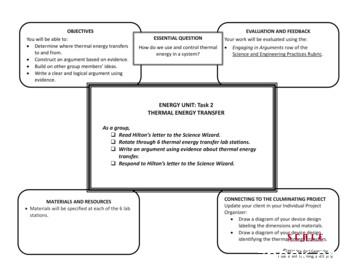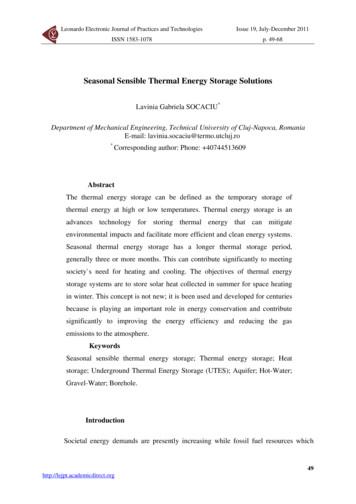Section 16.2 Thermal Energy
Section 16.2Thermal Energy
Three States of MatterLowEnergyHigh School DanceSlow Song
Three States of MatterMedium EnergyHigh School DanceFast Song
Three States of MatterHighEnergyHigh School DanceMosh Pit
Three States of MatterLowEnergyMediumEnergyHighEnergy
Thermal EnergyThermal EnergyThe total potential and kinetic energy of all the particles in an objectThree things that thermal energy depends on:1. Mass of object2. Temperature of the object3. Phase of the object (solid, liquid, gas)
Temperature The measure of how hot or cold an object is compared to areference point Measured in Celsius Measures the average kinetic energy of the particles in asubstance. Kinetic energy is directly related to the speed of themolecules. The faster the particles/molecules are moving the higher thetemperature.
TemperatureImportantYou must understand that as objects are heated and gain energythat the molecules in that object move faster and tend to spreadoutAs we add heat to a solid block of ice, the molecule speed upand spread out and create a liquid, water. If we take heat away,molecules slow down and will create a solid, ice
Heat Heat is a measure of energy (Joules) Transfer of thermal energy from one object to the nextbecause of temperature difference. Heat flows naturally from hot objects to cold objects. HEAT and TEMPERATURE are NOT the same thing. Ex. A cold Lake Superior has more heat energy than a boilingpot of water.
Thermal ExpansionThermal ExpansionAn increase in the volume of a material due to a temperatureincrease.Thermal expansion occurs when particles of matter movefarther apart as temperature increases.
Specific HeatSpecific HeatThe amount of heat needed to raise the temperature of 1 gram of amaterial by 1º Celsius.FormulaQ m · c · tQ Heat (Joules)m mass (grams)c specific heat (J/g·ºC) t change in temperature (ºC)
Specific HeatExample #1How much heat is needed to raise the temperature of 100grams of water by 85ºC? The Specific heat of water is 4.18 J/g·ºCQ m · c · tQ 100 g · 4.18 · 85 CQ 35,530 J
Specific HeatExample #2How much heat is absorbed by a 750 gram iron skillet whenit’s temperature rises 100ºC? The Specific heat of iron is .449J/g·ºCQ m · c · tQ 750 g · .449 · 100 CQ 33,675 J
AssessmentTake the next few minutes to answer the questions in yourpacket. We will review the information after 10 minutes.Note:This information may be on your pop-quiz next week!!
AssessmentHeat always flows from:Hot to Cold
AssessmentHow are temperature and thermal energy different?TemperatureMeasure of how hot or cold an object is compared to areference pointThermal EnergyTotal potential and kinetic energy of all particles
AssessmentComplete the following with the words: slow, medium or fast.If something has a high temperature then the molecules of thatobject are moving:FastIf something has a low temperature then the molecules of thatobject are moving:Slow
AssessmentComplete the following with the words: slow, medium or fast.If something is a solid then the molecules of that object aremoving:SlowIf something is a liquid then the molecules of that object aremoving:MediumIf something is a gas then the molecules of that object are moving:Fast
AssessmentComplete the following with the words: close, spaced out, veryspaced outIf something is a solid then the molecules of that object are:CloseIf something is a liquid then the molecules of that object are:Spaced outIf something is a gas then the molecules of that object are:Very Spaced Out
AssessmentMr. Holbrook blows up a balloon. He puts the balloon in the freezerand observes the changes. He puts the balloon next to the heaterthen observes the changes.What would happen to the size of the balloon after he put in intothe freezer? Explain.The balloon would shrink because the molecules would slow downand move closer together.
AssessmentMr. Holbrook blows up a balloon. He puts the balloon in the freezerand observes the changes. He puts the balloon next to the heaterthen observes the changes.What would happen to the size of the balloon after he put in nearthe heater? Explain.The balloon would expand because the molecules would speed upand move farther apart.
AssessmentCalculate the Heat Transferred (Q) for each of the following:The Specific heat of iron is 0.449 J/g·ºC. The mass of the iron skilletis 500 grams and the temperature change is 95 degrees Celsius.What is the heat transferred?Q m · c · tQ 500 g · 0.449 · 95 CQ 21,327.5 J
Section 16.2 Thermal Energy . Three States of Matter Low Energy High School Dance Slow Song . Three States of Matter Medium Energy . Energy . Thermal Energy The total potential and kinetic energy of all the particles in an object Three things that thermal energy depends on: 1
changes to thermal energy. Thermal energy causes the lamp's bulb to become warm to the touch. Using Thermal Energy All forms of energy can be changed into thermal energy. Recall that thermal energy is the energy due to the motion of particles that make up an object. People often use thermal energy to provide warmth or cook food. An electric space
using the words kinetic energy, thermal energy, and temperature. Use the space below to write your description. 5. Brainstorm with your group 3 more examples of thermal energy transfer that you see in everyday life. Describe where the thermal energy starts, where the thermal energy goes, and the results of the thermal energy transfer.
The electrical energy is transformed into thermal energy by the heat sources. The thermal energy has to meet the demand from the downstream air-conditioning system. Thermal en-ergy storage systems can store thermal energy for a while. In other words the storages can delay the timing of thermal energy usage from electricity energy usage. Fig. 1 .
Energies 2018, 11, 1879 3 of 14 R3 Thermal resistance of the air space between a panel and the roof surface. R4 Thermal resistance of roof material (tiles or metal sheet). R5 Thermal resistance of the air gap between the roof material and a sarking sheet. R6 Thermal resistance of a gabled roof space. R7 Thermal resistance of the insulation above the ceiling. R8 Thermal resistance of ceiling .
The thermal energy storage can be defined as the temporary storage of thermal energy at high or low temperatures. Thermal energy storage is an advances technology for storing thermal energy that can mitigate environmental impacts and facilitate more efficient and clean energy systems.
of matter. 474 Chapter 16 FOCUS Objectives 16.1.1 Explain how heat and work transfer energy. 16.1.2 Relate thermal energy to the motion of particles that make up a material. 16.1.3 Relate temperature to thermal energy and to thermal expansion. 16.1.4 Calculate thermal energy, temp
Lesson 3.1: “Thermal Energy Is NOT Temperature” 66 Warm-Up 67 Reading “Thermal Energy Is NOT Temperature” 68 Homework: Sim Mission 69 Lesson 3.2: Thermal Energy and Temperature Change 70 Warm-Up 71 Rereading “Thermal Energy Is NOT Temperature” 72 Re
ALEX RIDER SERIES POINT BLANK GOING DOWN MICHAEL J. ROSCOE was a careful man. The car that drove him to work at quarter past seven each morning was a custom-made Mercedes with reinforced steel plates and bulletproof windows. His driver, a retired FBI agent, carried a Beretta subcompact automatic pistol and knew how to use it. There were just .























